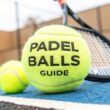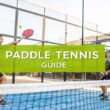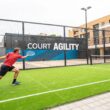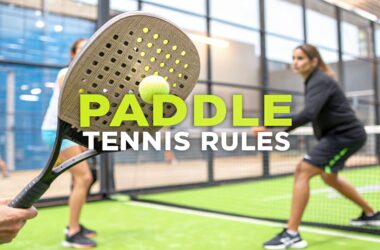In the fast-paced, dynamic world of padel, victory is often decided in fractions of a second. The ability to explode towards the net for a volley, change direction to retrieve a tricky 'bandeja', or rapidly adjust your position for a defensive lob isn't just an advantage, it's a necessity. While technique and strategy are crucial, they are built upon a foundation of elite physical conditioning. This is where targeted training becomes a game-changer, and specific agility and speed drills are the key to unlocking superior performance.
This guide moves beyond generic fitness advice, providing a curated roundup of eight specific drills designed to transform your movement on the court. We will break down each exercise, explaining not just the 'how' but the 'why', linking each drill directly to on-court padel scenarios. You will learn actionable techniques to improve your explosive power, reaction time, and multi-directional quickness. From foundational ladder work that refines footwork to advanced, reactive circuits that mimic real match pressure, this collection is your blueprint for becoming a more dominant and athletic player. Prepare to elevate your game from the ground up.
1. Ladder Drills (Agility Ladder Training): Mastering Padel Footwork Precision
The agility ladder is a foundational tool for any padel player aiming to enhance their on-court movement. It's not just about speed; it’s about neuromuscular re-education. This simple piece of equipment forces precise, rapid, and repetitive foot placements in a confined space, directly mimicking the quick adjustments needed around the net or when defending the back glass.
By practicing various patterns, you train your brain and feet to work in perfect sync, making complex movements subconscious and automatic. This translates directly to superior court positioning, quicker recovery after a powerful bandeja, and the agility to react to unpredictable shots. Think of it as learning the grammar of movement; mastering it makes every other action on the court more fluent and effective.
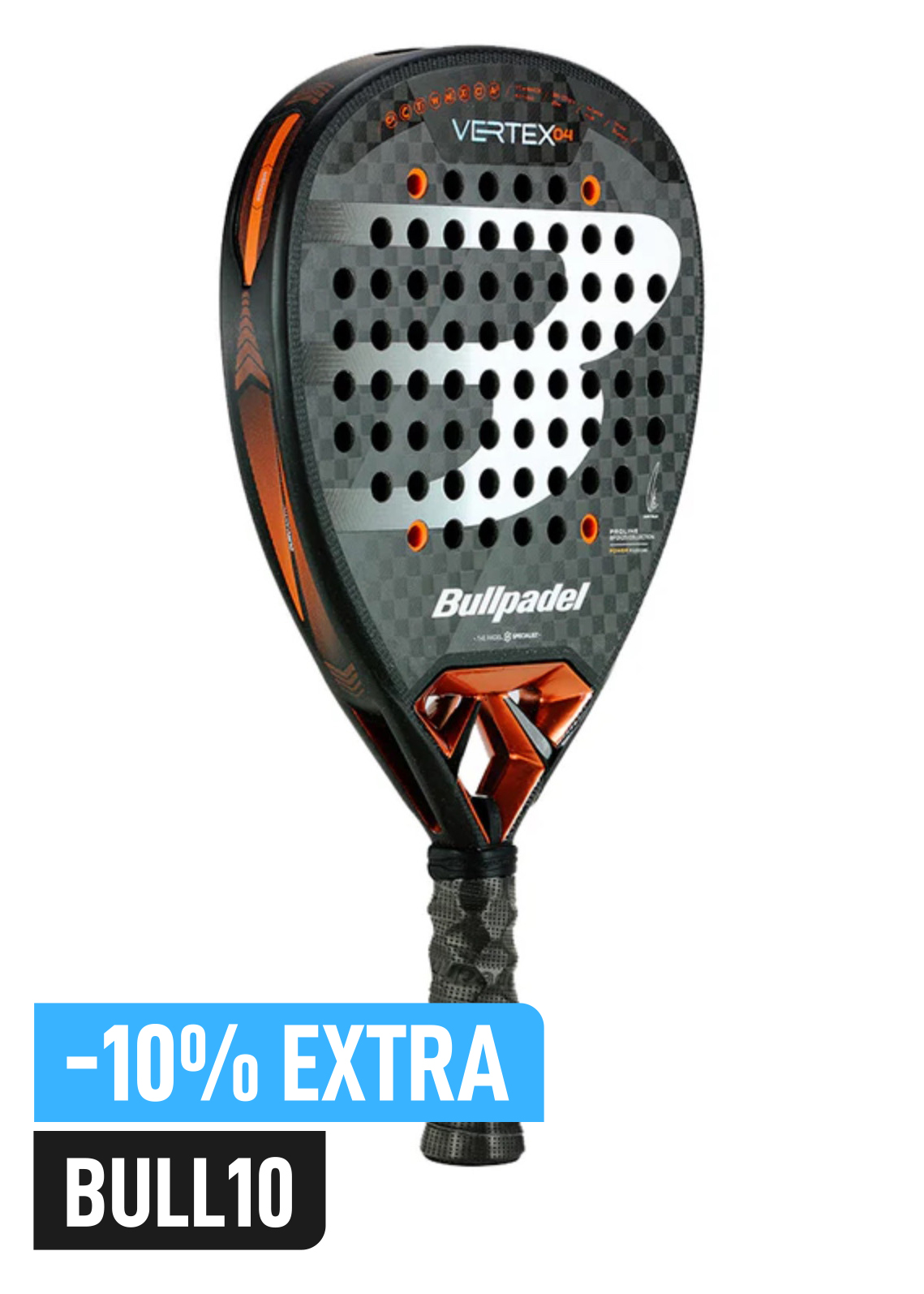
Buy the best padel gear to level up your next game!
CHECK OUT this deal from Padel Market!Get ready to take your game to the next level with the latest padel gear from Padel Market! Fast EU and Worldwide Shipping
Why It Works for Padel
Padel is a game of inches and split-second decisions. Ladder drills build the essential footwork patterns required for:
- Net Play: Small, explosive steps to prepare for a quick volley or block.
- Specialty Shots: Adjusting your feet precisely for a vibora after being pushed back by a lob.
- Court Recovery: Taking rapid, efficient steps to regain the central position after a wide defensive shot.
- Wall Defense: Using quick, controlled footwork to get into the optimal position to play the ball off the glass.
Implementing Ladder Drills Effectively
To get the most out of your training, focus on quality over quantity. The following bar chart breaks down the standard setup for an effective ladder drill session.
The chart highlights the ideal parameters for a session focused on developing agility and speed, ensuring the drills are both challenging and sustainable.
Start slowly, emphasizing accurate foot placement in each square before increasing your pace. Keep your head up and eyes forward as if you were tracking the ball, maintaining a low, athletic stance. A great way to make these agility and speed drills more padel-specific is to finish each pattern by sprinting five meters forward to simulate closing in on a short ball.
2. Cone Drills (5-10-5 Pro Agility Shuttle): Building Explosive Directional Changes
The 5-10-5 Pro Agility Shuttle, a benchmark drill in professional sports like the NFL Combine, is exceptionally effective for padel. This drill trains your body to accelerate, decelerate, and re-accelerate in multiple directions over short distances, a sequence that defines nearly every point played. It's not just a test of straight-line speed; it’s a measure of explosive change of direction.
Practicing this shuttle forces you to stay low, manage your center of gravity, and generate immense power from a near-standstill. This directly translates to the dynamic movements in padel, such as scrambling for a drop shot after being pushed deep or quickly changing direction to cover your partner's side of the court. Mastering this drill builds the core agility needed to turn defensive situations into offensive opportunities.
Why It Works for Padel
Padel demands rapid, multi-directional bursts of speed. The 5-10-5 shuttle is one of the most effective agility and speed drills because it specifically develops:
- Defensive Scrambling: The ability to sprint left, then aggressively cut right to defend a cross-court smash.
- Net Dominance: Rapidly covering the net area to intercept volleys and put away short balls.
- Split-Step Effectiveness: Training the explosive first step needed after a split-step to react to an opponent's shot.
- Recovery and Repositioning: Quickly returning to the "home" position after being pulled wide by a bandeja or vibora.
Implementing Cone Drills Effectively
To execute the 5-10-5 shuttle for padel, set up three cones in a straight line, each five yards apart. Start at the center cone. Sprint to the cone on your right and touch it, immediately change direction and sprint ten yards to the far-left cone and touch it, then sprint back five yards to the starting cone.
For maximum benefit, concentrate on your technique. Stay low through every turn, planting your outside foot hard to push off explosively in the new direction. Keep your hips and shoulders square as you change direction to maintain balance and power. Focus on accelerating aggressively out of each turn, as that first step is often what makes the difference between winning and losing a point. Practice starting in both left and right directions to ensure balanced development.
3. T-Drill (T-Test Agility Drill): Mastering Multi-Directional Padel Movement
The T-Drill is a classic test of multi-directional speed and is exceptionally relevant to the demands of padel. It’s not just about linear sprints; it’s about the ability to accelerate, decelerate, and change direction fluidly. This drill forces an athlete to transition from a forward sprint to a lateral shuffle and then into a backpedal, all within a confined, T-shaped area.
This sequence perfectly mirrors the dynamic movement required in a padel rally. You sprint forward for a drop shot, shuffle sideways along the net to cover a volley, and then backpedal quickly to defend a lob. The T-Drill trains your body to make these transitions efficiently and without hesitation, improving your ability to cover the entire court and maintain a strong defensive or offensive position.
Why It Works for Padel
Padel requires rapid shifts between different types of movement. The T-Drill builds the specific physical literacy needed for:
- Net Coverage: Sprinting to the net, then shuffling left and right to intercept volleys and smashes.
- Defensive Transitions: Moving from a forward position to backpedaling to get behind a deep lob.
- Covering the "T": The drill's pattern directly simulates defending the central "T" position at the net, a crucial aspect of doubles play.
- Body Control: Maintaining a low center of gravity while changing direction, which is essential for hitting stable shots like the bandeja or vibora on the move.
Implementing the T-Drill Effectively
To get the most from this classic agility and speed drill, your focus should be on clean transitions and maintaining proper athletic posture. Quality of movement must always come before raw speed, especially when you are starting out.
Set up three cones in a line, five yards apart. Place a fourth cone ten yards from the center cone, forming a "T". Start at the bottom cone, sprint forward and touch the center cone, shuffle left and touch the left cone, then shuffle all the way across to touch the right cone. Finish by shuffling back to the center cone and backpedaling to the start. Focus on keeping your feet from crossing during shuffles and staying low to the ground.
4. Reactive Agility Drills: Forging Split-Second Padel Instincts
Reactive agility drills move beyond rehearsed patterns, introducing an element of unpredictability that closely mirrors real-game scenarios. Instead of knowing where to run next, you must react to an external cue, such as a coach's signal, a flashing light, or a partner's movement. This forces a crucial connection between perception, decision-making, and physical execution, training your brain to process information and initiate a response almost instantaneously.
This type of training bridges the gap between structured practice and the chaotic, fluid nature of a padel match. By engaging your cognitive abilities alongside your physical ones, you develop the capacity to handle unexpected lobs, surprise drop shots, and fast-paced net exchanges with instinctual, efficient movements. These agility and speed drills are less about pre-programmed footwork and more about developing true athletic intelligence.

Buy the best padel gear to level up your next game!
CHECK OUT this deal from Padel Market!Get ready to take your game to the next level with the latest padel gear from Padel Market! Fast EU and Worldwide Shipping
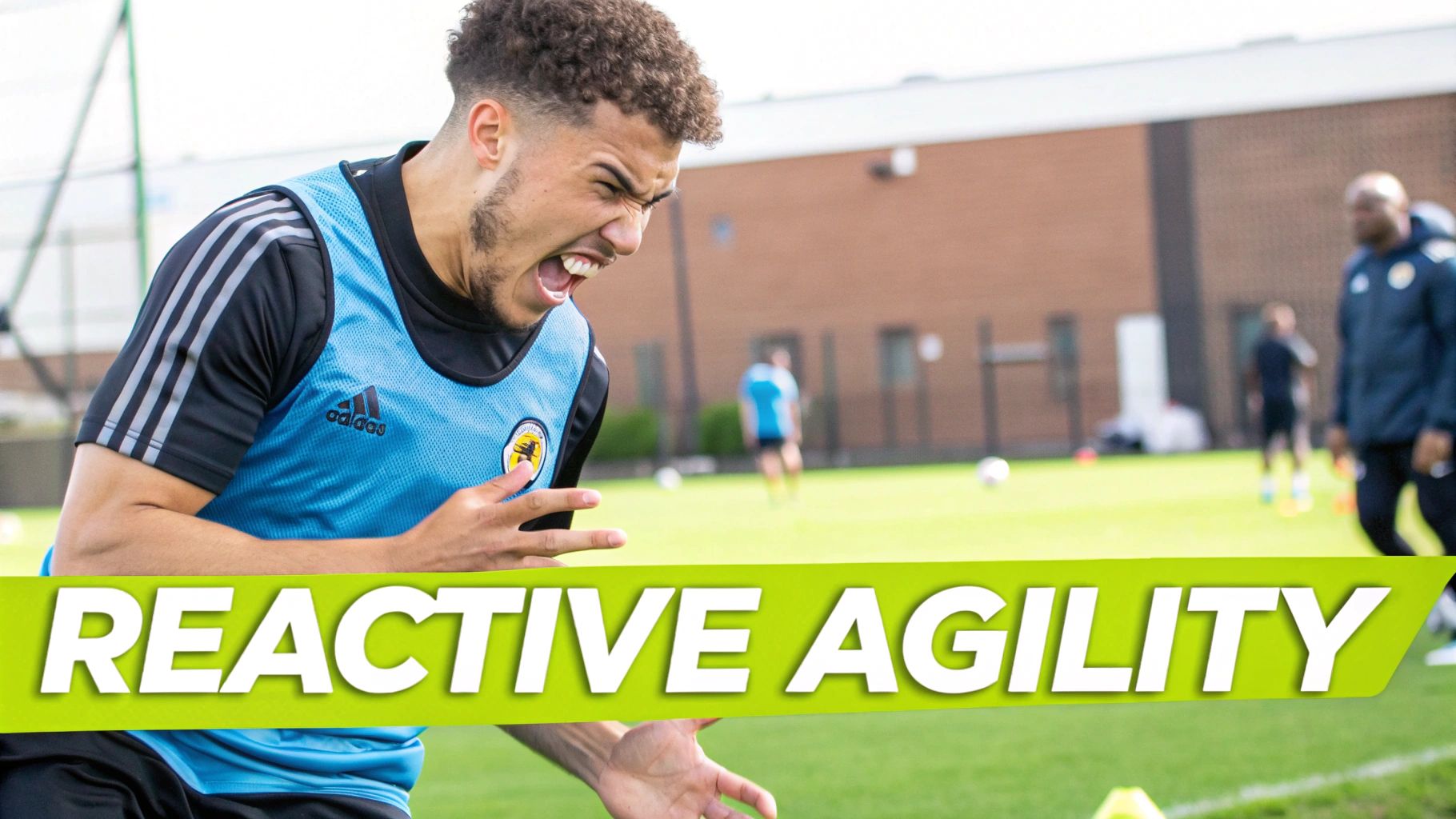
Why It Works for Padel
Padel is defined by reaction. Unlike many sports with predictable plays, the ball's interaction with the glass walls creates countless unpredictable angles. Reactive drills directly train the skills needed for:
- Defensive Reactions: Quickly changing direction to play a double-glass rebound that comes off at an unexpected angle.
- Net Anticipation: Responding instantly to an opponent’s last-second shot choice during a rapid volley exchange.
- Partner Coordination: Adjusting your court position in response to your partner's movement or a surprise offensive shot from the other side.
- Lob Defense: Making a split-second decision to either smash a high lob or let it hit the back glass based on its trajectory and depth.
Implementing Reactive Agility Drills Effectively
The key to these drills is creating uncertainty. You need a stimulus that dictates your movement, forcing you to think and act on the fly.
Start with simple cues and master the foundational movements before increasing the complexity. For instance, have a partner or coach stand in front of you and point left or right; you then shuffle or sprint in that direction. As you advance, you can use colored cones where your partner calls out a color, forcing you to identify and sprint to the correct one. Incorporating these drills sharpens not just your body but your mind, a critical component in high-pressure match situations. For a deeper dive into enhancing these specific skills, you can learn more about how to get better reflexes.
5. Plyometric Agility Drills: Forging Explosive Padel Power
Plyometric agility drills are the pinnacle of explosive training, combining rapid jumping and bounding movements with sharp directional changes. This advanced method isn't just about moving fast; it’s about generating maximum force in minimal time. By utilizing the muscle's stretch-shortening cycle, these exercises train your body to absorb force and immediately redirect it into an explosive action, a skill crucial for every powerful movement on the padel court.
This form of training conditions your nervous system to react with explosive power, turning defensive scrambles into offensive opportunities. Imagine exploding upwards for an overhead smash or launching laterally to cut off a sharp cross-court shot. Plyometrics build the raw, reactive strength that makes these high-impact plays possible, giving you a significant physical advantage over opponents who rely solely on conventional speed.
Why It Works for Padel
Padel demands repeated bursts of explosive, multi-directional power. Plyometric agility drills directly develop the physical qualities needed for:
- Powerful Smashes: Generating explosive ground force to get maximum height and power on a remate.
- Aggressive Net Play: Performing split-steps and explosive lunges to intercept volleys with authority.
- Off-the-Glass Power: Rapidly absorbing the force of a rebound and converting it into a powerful attacking shot.
- Dynamic Defense: Bounding laterally to cover the court and return difficult, wide-angled shots with stability.
Implementing Plyometric Agility Drills Effectively
Safety and technique are paramount with high-impact plyometrics. Always perform these agility and speed drills when you are fresh, never when fatigued, to ensure your neuromuscular system is at its peak.
Begin with a solid strength base before incorporating these advanced drills. Focus on perfect form and landing mechanics, absorbing each landing softly to protect your joints. Allow for full recovery between sets, typically 2-3 minutes, to maintain the quality of each explosive repetition. A great progression is to start with simple box jumps before adding directional changes, like a box jump followed by a 90-degree turn and a sprint. For more ways to enhance your explosive quickness, you can learn more about drills to improve reaction time, which complements plyometric training perfectly.
6. Speed Ladders and Hurdle Combinations: Developing Explosive Power
Combining agility ladders with low hurdles elevates standard agility and speed drills from simple footwork practice to a dynamic power-building exercise. This advanced method forces the body to transition rapidly between different movement planes and heights, challenging your neuromuscular system to adapt instantly. The drill involves executing a precise pattern through the ladder and then immediately clearing a series of low hurdles.
This combination develops both stride frequency (from the ladder) and stride power (from the hurdles), a potent mix for on-court explosiveness. It trains you to maintain coordination while changing your vertical and horizontal momentum, which is crucial for moving from a defensive crouch to an aggressive forward sprint. This is the kind of training that separates a quick player from a truly powerful one.
Why It Works for Padel
Padel demands constant shifts in movement type, from small adjustment steps to explosive sprints. This combined drill directly enhances the physical qualities needed for:
- Explosive First Step: Launching forward to attack a weak return or a short ball at the net.
- Net-to-Baseline Transitions: Quickly covering the court after a lob forces you back from an aggressive net position.
- Dynamic Defense: Generating power from a low stance to spring sideways for a difficult bandeja or off-the-wall shot.
- Maintaining Balance: Controlling your body's momentum while moving at high speed and different heights, crucial for shot stability.
Implementing Ladder and Hurdle Drills Effectively
The key to this advanced drill is mastering each component before combining them. Start with a simple ladder pattern followed by two or three low hurdles (6-12 inches high) placed about a meter apart. Your focus should be on creating a seamless, rhythmic flow between the two obstacles, not just rushing through them.
Maintain a low center of gravity and use your arms to drive your momentum through the hurdles. As you become more proficient, you can increase the complexity of the ladder pattern, raise the hurdle height slightly, or decrease the distance between them to challenge your reaction time. These agility and speed drills are intense, so integrate them into your routine once or twice a week to allow for proper recovery and adaptation.
7. Cutting and Deceleration Drills: Mastering Explosive Stops and Starts
The ability to slam on the brakes and instantly accelerate in a new direction is what separates good padel players from great ones. Cutting and deceleration drills are specialized exercises designed to train exactly that: controlled, explosive changes of direction. They focus on teaching your body to absorb force safely when stopping and then re-channel that energy into a powerful first step in a different direction.
This is a critical component of padel movement, where you’re constantly reacting to lobs, defending wide shots, and closing the net. Mastering these movements not only makes you faster and more effective but also significantly reduces the risk of common joint injuries, particularly to the knees and ankles. It’s about turning a reactive scramble into a proactive, powerful repositioning.
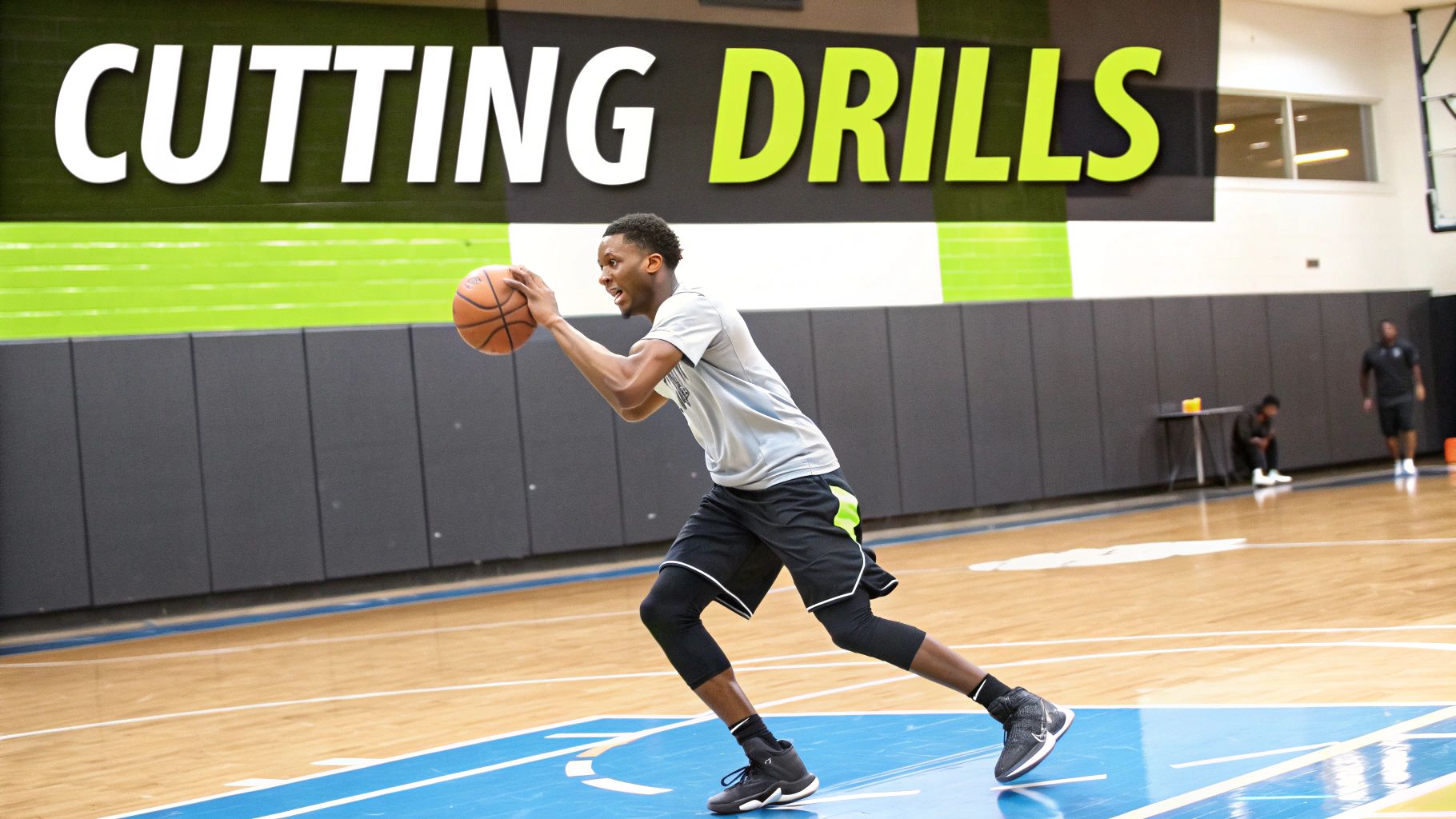
Why It Works for Padel
Padel is a game defined by rapid transitions from offense to defense. Cutting and deceleration are the physical mechanisms behind these transitions. These drills are essential for:
- Defensive Recovery: Sprinting to the back glass for a lob and immediately cutting back towards the center to cover the court.
- Net Dominance: Quickly changing direction to intercept a cross-court volley after faking a move down the line.
- Chiquita Returns: Sprinting forward to attack a short ball and then decelerating to hold your position at the net without overrunning it.
- Injury Prevention: Strengthening the muscles and improving the biomechanics needed to handle the high-stress forces of sudden stops. To maximize the benefits of these agility and speed drills, consider incorporating comprehensive injury prevention tips into your routine.
Implementing Cutting Drills Effectively
Proper form is paramount to avoid injury and gain maximum benefit. Start by marking out a simple course with cones. For example, sprint 5 meters, plant your outside foot, and cut 90 degrees to the left, sprinting another 5 meters. Focus on sinking your hips and maintaining a low center of gravity as you plant your foot to change direction.
Keep your head up, scanning the court as you would in a real match. Begin at 50-60% of your maximum speed to perfect the mechanics before gradually increasing the intensity. Your arm action is also crucial for maintaining balance and generating momentum out of the cut. For those looking to dive deeper into this topic, you can learn more about change-of-direction drills on Padel Rumors.
8. Sport-Specific Agility Circuits: Mimicking Padel's Rhythmic Chaos
While isolated drills build foundational skills, sport-specific agility circuits are where training truly translates to on-court dominance. These are not random exercises but customized sequences that replicate the exact movement patterns, energy demands, and decision-making pressures of a live padel rally. They are the dress rehearsal for the main performance.
A circuit might start with a defensive sprint to the back glass, transition to a side shuffle for a bandeja, and finish with an explosive forward movement to attack the net. This approach trains your body to flow seamlessly between different actions, just as you would in a high-pressure point. It bridges the gap between raw physical ability and tactical, game-ready athleticism.
Why It Works for Padel
Padel is defined by its rapid transitions between offense and defense. Sport-specific circuits build the physical and mental endurance to handle these shifts without a drop in performance. They are crucial for:
- Rally Simulation: Training your body to handle the start-stop, multi-directional nature of a long point.
- Shot-to-Movement Linking: Connecting the footwork for a vibora directly into the recovery steps needed to defend the next shot.
- Tactical Stamina: Maintaining precise footwork and explosive power even when fatigued deep into the third set.
- Cognitive Agility: Forcing you to think about the next shot while still executing the current movement, improving on-court decision-making.
Implementing Padel Circuits Effectively
The key to a successful circuit is its direct relevance to the game. Generic fitness circuits won't cut it; every movement must have a purpose that you would find inside the glass court.
Start by mapping out a common point sequence. For example: defend a lob to the back corner, move laterally to hit a bandeja, then sprint forward to volley. Set up cones to mark each position on the court and perform the sequence at 70% intensity, focusing on perfect form. As you improve, increase the speed to match game-level intensity and reduce the rest time between circuits to build endurance. Incorporating your padel racket and shadow swinging at each station makes these agility and speed drills even more effective, building muscle memory for both movement and technique simultaneously.
Agility & Speed Drill Comparison Matrix
| Agility Drill | Implementation Complexity 🔄 | Resource Requirements ⚡ | Expected Outcomes 📊 | Ideal Use Cases 💡 | Key Advantages ⭐ |
|---|---|---|---|---|---|
| Ladder Drills (Agility Ladder) | Low – simple setup, multiple patterns | Low – portable ladder, small space | Improves coordination, foot speed, muscle memory | All skill levels, limited spaces | Inexpensive, visual feedback, low joint impact |
| Cone Drills (5-10-5 Shuttle) | Moderate – 3 cones, linear distances | Low – cones, stopwatch | Develops acceleration/deceleration, direction changes | Combine tests, sport-agnostic speed/agility | Standardized benchmarks, easy progress measure |
| T-Drill (T-Test) | Moderate to high – 4 cones, multidirectional patterns | Low – cones, larger space required | Tests multi-directional agility and transitions | Sports requiring lateral & backward movement | Comprehensive, game-like movement simulation |
| Reactive Agility Drills | High – stimulus-response with variable patterns | Medium to high – equipment or partner needed | Enhances decision-making speed and reaction time | Game situation simulation, cognitive integration | High game transfer, engaging, improves reaction |
| Plyometric Agility Drills | High – complex, high intensity | Medium – space, strength prerequisites | Builds reactive strength, explosive power | Advanced athletes, jumping & sprint sports | Develops power, neuromuscular control |
| Speed Ladders & Hurdles Combo | High – complex setup and sequencing | Medium to high – ladder + hurdles & space | Improves stride frequency, running mechanics | Sprint training, sports requiring complex footwork | Integrates multiple movement qualities |
| Cutting and Deceleration Drills | Moderate – technique focused | Low – cones or lines, controlled environment | Enhances deceleration, cutting biomechanics | Injury prevention, field/court sports | Injury reduction, energy-efficient cutting |
| Sport-Specific Agility Circuits | Very high – customized & multi-component | Medium to high – specialized equipment & design | Maximizes sport transfer, integrates fitness & skill | Sport-specific conditioning & skill training | Highest transfer to performance, highly engaging |
Integrating These Drills into Your Padel Routine
You now have a comprehensive toolkit of eight powerful agility and speed drills designed to transform your movement on the padel court. From the foundational footwork patterns of Ladder Drills to the explosive power of Plyometrics and the game-like reactions demanded by Sport-Specific Circuits, each drill targets a crucial component of padel athleticism. The common thread is clear: speed is not just about linear sprints; it's about efficient, controlled, and explosive multidirectional movement.
Mastering these exercises means moving beyond simply going through the motions. The true value lies in the details: maintaining a low center of gravity during Cone Drills, executing sharp, clean cuts in the T-Drill, and minimizing ground contact time in Plyometric Agility Drills. These are not just warm-ups; they are focused training sessions designed to re-engineer your neuromuscular pathways for quicker, more instinctual on-court reactions.
A Practical Framework for Implementation
Acquiring new skills is one thing; implementing them is another. True improvement comes from consistent, intelligent application. Don't try to master all eight drills at once. Instead, adopt a structured approach to integrate these powerful agility and speed drills into your existing routine.
- Assess and Select: Identify your primary weakness. Are you slow to react at the net? Do you struggle with recovering to the back glass? Select two or three drills that directly address these specific areas. For example, if your first-step quickness is lacking, prioritize Ladder Drills and the 5-10-5 Pro Agility Shuttle.
- Schedule with Intent: Dedicate 15-20 minutes before your padel sessions, two to three times a week, to perform your chosen drills. This pre-play activation will not only build long-term athleticism but also prime your body for the match ahead.
- Prioritize Quality Over Quantity: Your focus should be on perfect form, not just completing reps. Every movement should be crisp, controlled, and intentional. A perfectly executed drill at 80% speed is far more beneficial than a sloppy one at 100%. Film yourself to analyze your technique and make precise adjustments.
- Progress and Adapt: As you become more proficient, begin to mix in new drills or increase the complexity of the ones you've mastered. Add a reactive component to your Cone Drills with auditory or visual cues, or combine Speed Ladders with Hurdles to challenge your coordination under fatigue.
For players seeking personalized guidance to effectively integrate these advanced drills and ensure proper form, understanding the role of a personal trainer can be a valuable step. A qualified professional can help tailor a program that aligns perfectly with your individual goals and physical condition.
By strategically integrating these agility and speed drills into your training, you're not just practicing; you're building a more athletic, resilient, and dominant version of yourself on the court. You are laying the foundation to anticipate the "bandeja," sprint for the drop shot, and change direction with the explosive grace of a professional. The speed is within you; these drills are simply the key to unlocking it.
Ready to pair your newfound speed with the latest gear and pro insights? Visit Padel Rumors for in-depth reviews on rackets that complement an agile playing style, tactical breakdowns, and the latest news from the world of professional padel. Elevate your game from the ground up at Padel Rumors.


